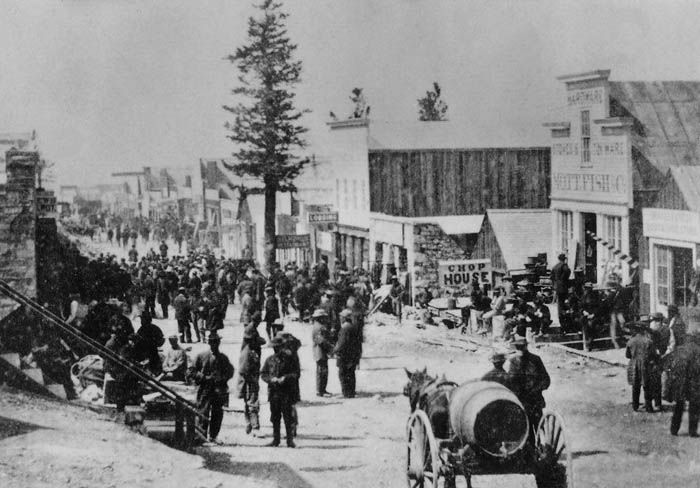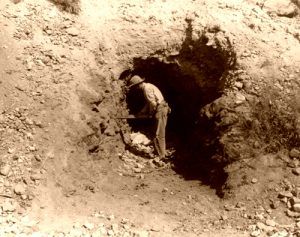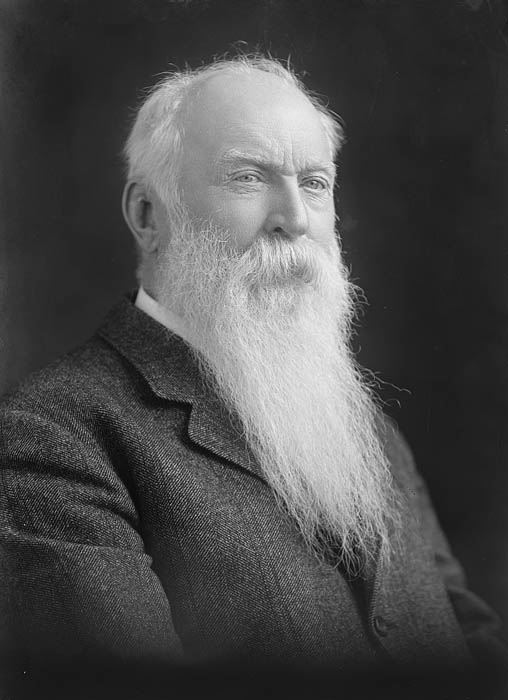By William Daugherty, 1891
L.P. Tenney was the Mining Recorder on Treasure Hill, Nevada, in the early days of the White Pine excitement during 1868 and ’69. Tens of thousands knew him, for Treasure Hill was plastered three feet deep with mining locations on top of each other. Tenney recorded everything offered, leaving it to the courts and lawyers to settle the title of ownership afterward. The extent of his patronage was so great that he waxed rich, and after the excitement subsided, he gathered up his golden gains and retired to San Francisco.
There, amid a life of leisure, he would occasionally grow communicative and recount his early struggles in California. One of his cherished reminiscences was recounting his first placer mining attempt. In 1852, he landed in San Francisco and went at once to the mines, stopping at Grass Valley. Early the next morning, he made his way up the creek and accosted the first miner by asking him how much he would charge to teach him how to mine. The miner put him to work transporting pay dirt in a bucket from the excavation to the rocker on the creek’s banks. After a three-day apprenticeship, served without pay, Tenney located a claim for himself and, like all greenhorns, chose a spot that no one else would touch, and all looked on him as a d—–d fool for digging there.
But Tenney was in earnest and was going for pay gravel so eagerly that he soon had a shaft down 15 feet and out of reach of further depth unless he got assistance. He formed a partnership with two strangers who aided in sinking it to a depth of 30 feet and then said he could go on, and if he struck anything, they would divide with him while they left for other fields. Tenney was discouraged, but learning of two strangers, one of whom was called White-Headed Bill, that wanted an opportunity to engage in mining, he made a proposition and, with their assistance, resumed work and running adrift from the bottom of the shaft they struck it rich and began taking out from $200.00 to $300.00 a day.
Two weeks after his first partners departed, they returned, and while Tenney was at work in the drift and White-Headed Bill and his comrade were engaged in hoisting, they came to the shaft and demanded their claim. Tenney heard an angry discussion going on, followed by blows and knock-downs. As hurriedly as he could, he climbed the rope to the surface and found that the neighboring miners had rushed in and separated the two principal combatants at a time when White-Headed Bill was giving one of the returned locators a severe thumping.
The miners suggested an immediate trial of property rights, formed a circle and chose a judge and jury. They proceeded with the trial, one from each side acting as an attorney and White-Headed Bill acting for Tenney’s side. It was soon demonstrated that the original locators had abandoned the claim and been absent for over ten days, which, by the district laws then in force, gave the claim to Tenney and his last partners. They resumed their work, and at the commencement of the rainy season, they divided $15,000.00 as the result of their labor and sold the claim for $1,500.00, supposing it was exhausted. It afterward proved to be the richest in the district, gained wide renown, known as the celebrated Coyote lead. The fighting attorney and stalwart miner, White-Headed Bill, later became the champion of free coinage and the Honorable William M. Stewart.
By William Daugherty in 1891. Compiled and edited by Kathy Alexander/Legends of America, updated April 2024.
Also See:
Mining on the American Frontier
Pioneers on the Nevada Frontier (Reno Evening Gazette)
About the Author: This article was written by William Daugherty for the Reno Evening Gazette in 1891. The Reno Evening Gazette was first published on October 12, 1876, and continued for the next 107 years. In 1977, it was merged with the Nevada State Journal and continues to exist today as the Reno Gazette-Journal. Note: The article is not verbatim, as spelling errors, minor grammatical changes, and editing have occurred for the ease of the modern reader.



